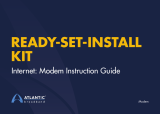
FCC Declaration of Conformity
Motorola, Inc., Broadband Communications Sector, 101 Tournament Drive, Horsham, PA 19044, 1-215-323-1000, declares under sole responsibility that the
WR850G/GP, WE800G, WA840G/GP, WN825G/GP, WPCI810G/GP, WU830G, and BR700 comply with 47 CFR Parts 2 and 15 of the FCC Rules as Class
B digital devices. These devices comply with Part 15 of FCC Rules. Operation of these devices is subject to the following two conditions: (1) These devices
may not cause harmful interference, and (2) these devices must accept any interference that may cause undesired operation.
Wireless LAN Information
The WR850G/GP, WE800G, WA840G/GP, WN825G/GP, WPCI810G/GP, and WU830G Wireless LAN products are wireless network products that use
Direct Sequence Spread Spectrum (DSSS) radio technology. These products are designed to be inter-operable with any other wireless DSSS type product that
complies with:
• The IEEE 802.11 Standard on Wireless LANs (Revision B and Revision G), as defined and approved by the Institute of Electrical Electronics
Engineers.
• The Wireless Fidelity (WiFi) certification as defined by the Wireless Ethernet Compatibility Alliance (WECA).
Wireless LAN and your Health
The WR850G/GP, WE800G, WA840G/GP, WN825G/GP, WPCI810G/GP, and WU830G, like other radio devices, emit radio frequency electromagnetic
energy, but operate within the guidelines found in radio frequency safety standards and recommendations.
Restrictions on Use of Wireless Devices
In some situations or environments, the use of wireless devices may be restricted by the proprietor of the building or responsible representatives of the
organization. For example, using wireless equipment in any environment where the risk of interference to other devices or services is perceived or identified
as harmful.
If you are uncertain of the applicable policy for the use of wireless equipment in a specific organization or environment, you are encouraged to ask for
authorization to use the device prior to turning on the equipment.
The manufacturer is not responsible for any radio or television interference caused by unauthorized modification of the devices included with this product, or
the substitution or attachment of connecting cables and equipment other than specified by the manufacturer. Correction of interference caused by such
unauthorized modification, substitution, or attachment is the responsibility of the user.
The manufacturer and its authorized resellers or distributors are not liable for any damage or violation of government regulations that may arise from failing
to comply with these guidelines.
FCC Certification
The WR850G/GP, WE800G, WA840G/GP, WN825G/GP, WPCI810G/GP, and WU830G contain a radio
transmitter and accordingly have been certified as compliant with 47 CFR Part 15 of the FCC Rules for intentional
radiators. Products that contain a radio transmitter are labeled with FCC ID and the FCC logo.
Caution: Exposure to Radio Frequency Radiation.
To comply with the FCC RF exposure compliance requirements, the separation distance between the antenna and any person’s body (including hands, wrists,
feet and ankles) must be at least 20 cm (8 inches).
Canada - Industry Canada (IC)
The wireless radio of this device complies with RSS 210 and RSS 102 of Industry Canada.
This Class B digital device complies with Canadian ICES-003 (NMB-003).
Cet appareil numérique de la classe B respects toutes les exigences du Règlement sur le matériel brouilleur du Canada.
Copyright © 2005 Motorola, Inc.
All rights reserved. No part of this publication may be reproduced in any form or by any means or used to make any derivative work (such as
translation, transformation or adaptation) without written permission from Motorola, Inc.
Motorola reserves the right to revise this publication and to make changes in content from time to time without obligation on the part of Motorola
to provide notification of such revision or change. Motorola provides this guide without warranty of any kind, either implied or expressed,
including but not limited to, the implied warranties of merchantability and fitness for a particular purpose. Motorola may make improvements or
changes in the product(s) described in this manual at any time.
MOTOROLA and the Stylized M Logo are registered in the US Patent & Trademark Office. Microsoft, Windows, Windows Me, Windows XP,
Windows 95, Windows 98, Windows NT, Windows 2000, DirectX, MSN, and NetMeeting are either registered trademarks or trademarks of
Microsoft Corporation in the United States and/or other countries. Microsoft Windows screen shots are used by permission of Microsoft
Corporation. Wi-Fi is a registered trademark of Wireless Ethernet Compatibility Alliance, Inc. AOL is a registered trademark and Instant
Messenger is a trademark of America Online, Inc. QuickTime is a registered trademark of Apple Computer, Inc. Net2Phone is a registered
trademark of Net2Phone, Inc. Battle.net is a registered trademark of Blizzard Entertainment. Unix is a registered trademark of The Open Group.
The following websites are not sponsored, affiliated, or controlled by Motorola: www.dyndns.org, www.changeip.com, and www.ntp.org. All
other product or service names are the property of their respective owners.
Dipee.info






















